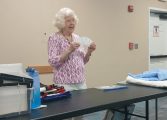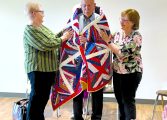“The purpose of this workshop is to explore ways of moving from doing tight, fussy, needlessly detailed illustration-type renderings, to creating more expressive fine art,” said Weidenheimer. “We will look at ways of transitioning a real photo into a less literal, more impressionistic, stylized or semi-abstract painting. A painting, like a poem, that is more evocative, suggesting more than it states, inviting more individuality.”
Weidenheimer began by showing examples including the primitive Lasko Cave drawings. In other examples, he suggested exaggeration or fractured style of the human form, remove shading and paint flat areas as well as the use of repetitive shapes are some of the ways to move toward abstraction.
“Try outlining objects, eliminating inner details and textures. Paint the outlined shapes with flat color, no shading, , color like you would see in a poster or cartoon,” he said.
“Decide which elements in the scene are most important or interesting to you and feature these in your painting.”
He explained the use of limiting the color palette as another creative way to relax the structure in ones’ work, suggesting sticking to two to three colors. Two might be predominate and warm while a cool color is introduced for interest. Picasso’s Blue or Red Period is a prime example.
“Reduce contrast and color intensity in the less important areas,” he said. “Try replacing all the colors with either different hues, or bolder or more muted colors.”
Regarding Impressionism, “Strokes matter,” he said, showing examples of Impressionistic masters using a variety of brush strokes including slashes, pointalism, and larger, looser strokes.
“It takes skill to make it look less than the original,” he said.
Another approach to creating paintings from photos is to use computer aided imagery or programs like Picasa, which can aid in creativity by distorting the photo and the subject. Backgrounds in paintings can be splashed on with several watercolors or diluted acrylics or a spray bottle used for a different effect.
Animals were shown in a variety of ways, from linear drawings to fractured shapes like stained glass or repetitive shapes. Landscapes were either a soft, diffused impressionistic style without hard edges or use rhythmic repetition with shapes and colors like a painting featuring bright yellow and orange trees against a blue background. Repetition with variety was shown in artist Tonya Bottomly’s work, a contemporary artist who flirts with primitive sophistication.
“Allow your personality, emotions and intellect to shape how you interpret the scene on your canvas. Don’t bore me,” he said in an attempt to get members to think beyond their limited imagination and explore other possible compositions.
Many of the members began thinking and seeing outside the four walls of their boxes to create something diverse. A new way of seeing seem to excite many of the members who were willing to give abstraction a try.




